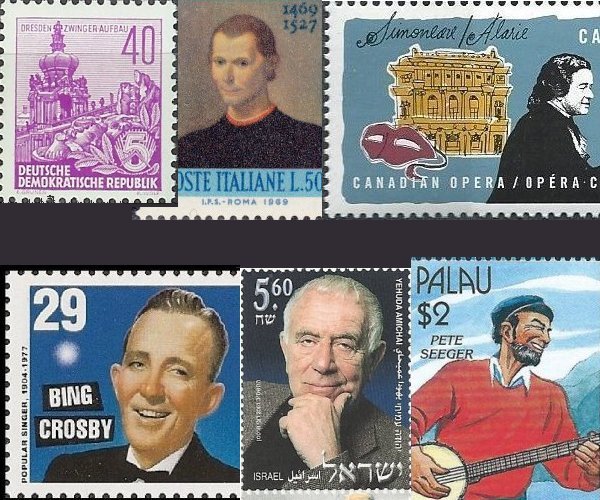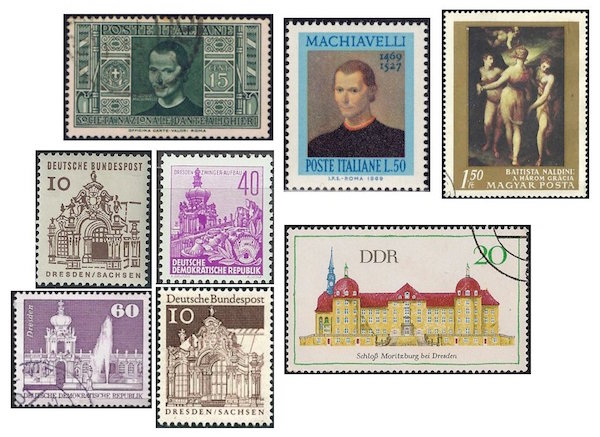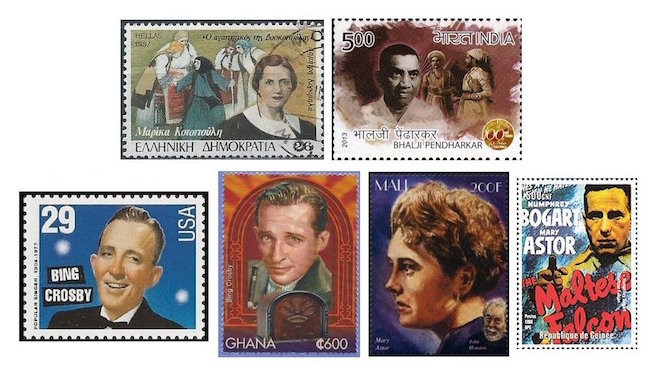The Arts on the Stamps of the World — May 3
An Arts Fuse regular feature: the arts on stamps of the world.

By Doug Briscoe
The Fame Game today is, I suppose, won by Bing Crosby, Pete Seeger, and Mary Astor, but we have many others to acknowledge: a 16th-century Italian painter, an important German Baroque architect, a Greek stage actress, another Indian film director (yesterday was Satyajit Ray, in case you missed it), a splendid Canadian tenor, an Israeli poet, and two stamp designers.
We begin, though, with a tip of the hat, or a flourish of the dagger, for Niccolò Machiavelli (3 May 1469 – 21 June 1527), just for The Prince, which has an unassailable place in Western literature.

Remaining in Italy, we greet the Florence-born painter Giovanni Battista Naldini (3 May 1535 – 18 February 1591). Around 1560 he went to Rome and was taken up by Vasari. Naldini painted altarpieces there as well as a cycle of John the Baptist frescoes in the church of Trinità dei Monti. Back in Florence he executed a pair of paintings for Francesco de Medici’s Studiolo in the Palazzo Vecchio. The Hungarian stamp of 1968 gives us Naldini’s Three Graces, which can be seen in greater detail here.
German master builder Matthäus Daniel Pöppelmann (3 May 1662 – 17 January 1736) was born in the town of Herford in Westphalia, about midway between Münster and Hannover. He was apprenticed six years in Saxony before proceeding to Dresden, where, following a disastrous fire in 1685, he helped in the rebuilding of the city. Eventually he was named court architect to Augustus the Strong, King of Poland and Elector of Saxony. Pöppelmann’s major work is the Zwinger Palace (1711-28), seen on stamps of both East and West Germany. Originally the Zwinger was not enclosed, but today it houses the Old Masters Picture Gallery (Gemäldegalerie Alte Meister), the Dresden Porcelain Collection, and the Royal Cabinet of Mathematical and Physical Instruments. Pöppelmann also designed a number of other grand palaces, including Schloss Moritzburg, also seen on a stamp from the DDR, and the more modest and charming Weinbergkirche in Pillnitz.
We leap forward to the 20th century for the rest of our subjects today. And our second collage is devoted entirely to thespians and filmmakers. Greek actress Marika Kotopouli (3 May 1887 – 11 September 1954) was born to actor parents and made her stage debut at the age of 16 before going to Paris for theatrical studies in 1906. By 1908 she was leading her own troupe and had her own theater. She developed a rivalry with another actress, Kyveli, that was as much political as it was artistic, but the two women worked together in later years. Another theater, built in 1936, bears her name today, as does the Marika Kotopouli Award, established in 1951 for Greek actors. Her repertoire covered ancient and modern Greek plays, Goethe, Ibsen, etc. Kotopouli made only a single film appearance (Bad Road, 1933). She died in her native Athens at the age of 67.
Born exactly ten years after Marika Kotopouli was Indian director, screenwriter, and producer Bhalji Pendharkar (3 May 1897 – 26 November 1994 ). He had his start in the silents and made over forty films between 1925 and 1969. Prominent among them are Shyam Sundar (1932) and Akashwani (1934), for both of which he wrote the screenplays. There is a 13-minute documentary about him on YouTube.

Harry Lillis Crosby, Jr. (May 2, 1903 – October 14, 1977) got his nickname “Bing” in childhood because of his liking for a parody newsletter called The Bingville Bugle—a neighbor took to calling him “Bingo from Bingville”. He was interested in and benefited from technology such as the advent of the microphone and magnetic tape and was something of an innovator in this area. He won an Oscar for Going My Way (1944) and has three stars on the Hollywood Walk of Fame, for recording, radio, and motion picture. I’ve felt an apparently unjustified disgust for Crosby ever since hearing of his reported abusiveness as related in his son Gary’s tell-all memoir of 1983; but apparently Bing, though something of a disciplinarian and not averse to corporal punishment, did not exceed the boundaries of what at the time was considered acceptable. On the other hand, he was a Republican.
Three years younger than Bing, to the day, was Mary Astor (born Lucile Vasconcellos Langhanke in Quincy, Illinois to a naturalized US citizen from Germany and an American mother, both teachers. Her father encouraged and even managed her acting career. Her first screen test was before Lilian Gish, who was so impressed that she shot a thousand feet of film. Paramount Pictures chose the name Mary Astor for her. John Barrymore arranged for her to be his co-star in the 1924 silent Beau Brummel. (He wanted to arrange for more than that, but Mary’s parents had eagle eyes.) Of course, Astor’s most famous role was as the conniving Brigid O’Shaughnessy in The Maltese Falcon (1941), but she won her Oscar (for Best Supporting Actress) for the same year’s The Great Lie. Mary Astor wrote five novels and two volumes of autobiography. She died, aged 81, on September 25, 1987.
Canadian tenor Léopold Simoneau, admired especially for his Mozart, was born on this day in 1916. He is shown on this stamp with his wife and frequent on-stage partner Pierrette Alarie. They were married from 1946 until his death at the age of 90 on August 24, 2006.
The late Pete Seeger (May 3, 1919 – January 27, 2014) was born to an old New England family. His parents were musical, his father a musicologist and composer, his mother a violinist and later a teacher at Juilliard. After their divorce, Charles Louis Seeger married the important composer Ruth Crawford. We tend to think of Pete Seeger as an activist folk singer of the 1960s, but his activism had much earlier beginnings. He joined the Young Communist League when he was seventeen and supported the Republican cause in the Spanish Civil War. His Songs for John Doe (1941) caused quite a stir with its anti-interventionist position (soon repudiated after Hitler declared war on the Soviet Union), and his group The Weavers was temporarily blacklisted in 1953. As late as 2013, Seeger performed at Farm Aid with Willie Nelson and others. It was in that year that his wife of seventy years, Toshi, died. He followed her six months later at the age of 94.

Some readers hold Yehuda Amichai (3 May 1924 – 22 September 2000) to be Israel’s greatest modern poet. He was born Ludwig Pfeuffer in Würzburg to an Orthodox family. In 1935, when he was 11, his family immigrated to Mandate Palestine. He served in the British Army during World War II, as well as in the Sinai War in 1956 and the Yom Kippur War in 1973. In the intervening years he published his first novel, Not of This Time, Not of This Place (1963). Of his standing as a poet, Ted Hughes called Amichai “one of the biggest, most essential, most durable poetic voices of this past century…One of the real treasures.”
Another Israeli artist is next. Miriam Karoly (May 3, 1925 – February 17, 1994 ) was also an immigrant, in her case from Vienna. She came to Haifa in 1939 and after studies in painting and graphic design found employment in the latter area. Posters, medals and coins, and postage stamps were her métier alongside her paintings, murals, sculptures, book cover illustrations, and work in porcelain. I show a few of her Israeli stamps; she also designed some for Ghana. When her husband became terminally ill, the couple decided to commit suicide together.
Another stamp designer, and yet another emigré, is Piotr Jerzy Naszarkowski (nah-shar-KOFF-ski; born 1952). A graduate of the Fine Art School of Warsaw, he worked as a stage designer for a puppet theater and then for Polish television, resigning in protest when martial law was declared by the government as a reaction to the Solidarity movement. Naszarkowski learned engraving at the Polish Banknote Printing House and moved to Sweden in 1989. Since 1985 he has designed and/or engraved over a hundred stamps, most of them for the Swedish Postal Service. Again, I offer a sampling of his work.
Just a few days ago we celebrated the birthday of Indian filmmaker Dadasaheb Phalke, and it so happens that today is the 104th anniversary of the release of his Raja Harishchandra, the first full-length Indian feature.
These writers have no stamps, but ought to: August von Kotzebue (1761–1819), William Inge (1913–1973), and May Sarton (1912–1995).
A graduate of the University of Massachusetts with a B.A. in English, Doug Briscoe worked in Boston classical music radio, at WCRB, WGBH, and WBUR, for about 25 years, beginning in 1977. He has the curious distinction of having succeeded Robert J. Lurtsema twice, first as host of WGBH’s weekday morning classical music program in 1993, then as host of the weekend program when Robert J.’s health failed in 2000. Doug also wrote liner notes for several of the late Gunther Schuller’s GM Recordings releases as well as program notes for the Boston Classical Orchestra. For the past few years he’s been posting a Facebook “blog” of classical music on stamps of the world, which has now been expanded to encompass all the arts for The Arts Fuse.
